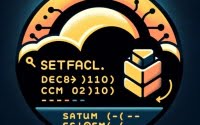‘patch’ Linux Command Guide (Syntax and Use Cases)

Are you finding it difficult to understand the ‘patch’ command in Linux? You’re not alone. Many developers find themselves in a similar situation, we’re here to help. Think of the ‘patch’ command as a versatile tool for applying changes to your files. It’s a handy utility that can significantly streamline your workflow in Linux.
In this guide, we’ll walk you through the process of using the patch command in Linux, from the basics to more advanced techniques. We’ll cover everything from the command’s syntax, its usage, to troubleshooting common issues and even alternative approaches.
So, let’s dive in and start mastering the patch command in Linux!
TL;DR: How Do I Use the Patch Command in Linux?
The
patchcommand in Linux is a powerful tool that updates files in a directory from one version to another based on a diff file. The syntax for the command is as follows,patch [options] [originalfile [patchfile]] < diff_file.
Here’s a simple example:
patch < diff_file
In this example, we’re using the patch command to apply changes from a diff file to the current directory. The ‘ This is just a basic usage of the patch command in Linux. There’s much more to learn about this versatile tool, including advanced usage and troubleshooting techniques. Continue reading for a comprehensive guide on mastering the patch command in Linux.
Table of Contents
- Basics Syntax and Usage of Patch
- Advanced Usage of Linux Patch Command
- Exploring Alternatives: Applying Patches Using Git
- Patch Command Pitfalls: Common Issues and Solutions
- Understanding Patching in Linux
- Patch Command in the Bigger Picture: Larger Projects and Other Tools
- Wrapping Up: Mastering the Patch Command in Linux
Basics Syntax and Usage of Patch
The patch command in Linux is a powerful tool, but it’s also straightforward to use once you understand its syntax and basic usage.
The general syntax of the patch command is as follows:
patch [options] [originalfile [patchfile]]
Here, options are the command options such as -p or -R, originalfile is the file you want to apply the patch to, and patchfile is the file containing the patch. However, it’s common to use the patch command in conjunction with input redirection (<), as shown in the TL;DR section.
Here’s a simple example of how to use the patch command:
echo 'Hello, World!' > file1.txt
echo 'Hello, Linux!' > file2.txt
diff -u file1.txt file2.txt > file.diff
patch file1.txt < file.diff
In this example, we first create two text files: file1.txt and file2.txt, with the contents ‘Hello, World!’ and ‘Hello, Linux!’, respectively. We then create a diff file file.diff which contains the differences between the two files. Finally, we use the patch command to apply the changes from file.diff to file1.txt.
If you open file1.txt after running the patch command, you’ll find that its content has been changed to ‘Hello, Linux!’.
The patch command is a powerful tool that can save you a lot of time when you need to apply changes to files. However, it’s not without its pitfalls. For instance, if the patch file is not compatible with the original file, the patch command may fail or produce unexpected results. Therefore, it’s important to always review the patch file before applying it.
Advanced Usage of Linux Patch Command
As you become more comfortable with the basic usage of the patch command, you can start to explore its more advanced features. These include applying patches to directories or using different options like -p or -R.
Before we get started on that, here’s a quick reference table of some of the most commonly used flags with the ‘patch’ command in Linux:
| Flag | Description | Example |
|---|---|---|
-p | Strips the smallest prefix containing num leading slashes from each file name found in the patch file. | patch -p1 < diff_file |
-R | Assumes that this patch was created with the old and new files swapped. | patch -R < diff_file |
-f | Assumes that you want to apply all the patches that can be applied. | patch -f < diff_file |
-l | Loosens the comparison algorithm to ignore white spaces. | patch -l < diff_file |
-s | Silent mode, only errors are reported. | patch -s < diff_file |
-v | Outputs additional information about the work being done. | patch -v < diff_file |
-i | Takes the patch from the specified file, not standard input. | patch -i diff_file original_file |
-o | Puts the patched files into the specified directory. | patch -o /path/to/dir < diff_file |
-d | Changes to the specified directory before doing anything else. | patch -d /path/to/dir < diff_file |
-r | Makes patch print a summary of rejects to the specified file. | patch -r rej_file < diff_file |
Now that we’ve covered that, let’s delve into these features in more detail.
Stripping Prefixes with -p
The -p option is used to strip the smallest prefix containing the specified number of leading slashes from each file name found in the patch file. This is useful when the patch file was created in a different directory structure.
Here’s an example:
patch -p1 < diff_file
In this example, the -p1 option tells patch to strip one leading slash from the file paths in the patch file. This allows the patch to be applied correctly even if the directory structure is different.
Reversing Patches with -R
The -R option allows you to reverse the patch. This is useful if you want to undo the changes made by a patch. Here’s an example:
patch -R < diff_file
In this example, the -R option tells patch to reverse the changes in the diff file. This effectively undoes the patch.
Applying Patches to Directories
The patch command can also apply patches to entire directories. Here’s an example:
patch -p0 -d /path/to/dir < diff_file
In this example, the -d option tells patch to change to the specified directory before applying the patch. The -p0 option tells patch not to strip any leading slashes from the file paths in the patch file.
Exploring Alternatives: Applying Patches Using Git
While the patch command is a powerful tool, it’s not the only way to apply patches in Linux. For those who work with Git, there’s an alternative method that might be more familiar: the ‘git apply’ command.
Applying Patches with ‘git apply’
The ‘git apply’ command reads a patch from standard input and applies it to files in a Git repository. This can be a more convenient way to apply patches if you’re already using Git for version control.
Here’s an example of how to use ‘git apply’ to apply a patch:
git apply diff_file
In this example, ‘git apply’ reads the patch from ‘diff_file’ and applies it to the files in the current Git repository.
echo 'Hello, World!' > file1.txt
echo 'Hello, Git!' > file2.txt
git diff --no-index file1.txt file2.txt > file.diff
git apply file.diff
cat file1.txt
# Output:
# Hello, Git!
In this example, we first create two text files: file1.txt and file2.txt, with the contents ‘Hello, World!’ and ‘Hello, Git!’, respectively. We then create a diff file file.diff which contains the differences between the two files. Finally, we use the ‘git apply’ command to apply the changes from file.diff to file1.txt. If you display the content of file1.txt after running the ‘git apply’ command, you’ll find that its content has been changed to ‘Hello, Git!’.
Benefits and Drawbacks of ‘git apply’
The ‘git apply’ command has several benefits over the patch command. It integrates seamlessly with Git, which makes it a convenient option if you’re already using Git for version control. It also supports more patch formats than the patch command, including Git’s own patch format.
However, ‘git apply’ also has its drawbacks. It only works with Git repositories, which makes it less versatile than the patch command. It also doesn’t support some of the patch command’s options, like -R for reversing patches.
In conclusion, while the patch command is a powerful and versatile tool for applying patches in Linux, the ‘git apply’ command can be a more convenient alternative if you’re working with Git.
Patch Command Pitfalls: Common Issues and Solutions
While the patch command is a powerful tool, it’s not without its challenges. Users might encounter issues such as patch failures or conflicts. Let’s discuss some of these common problems and how to solve them.
Patch Failures
One common issue is patch failure, which can occur for several reasons, such as an incompatible patch file or a changed source file. When a patch fails, the patch command generates a .rej file that contains the rejected changes.
Here’s an example of a patch failure:
echo 'Hello, World!' > file1.txt
echo 'Hello, Linux!' > file2.txt
diff -u file1.txt file2.txt > file.diff
echo 'Hello, Patch!' > file1.txt
patch file1.txt < file.diff
# Output:
# patching file file1.txt
# Hunk #1 FAILED at 1.
# 1 out of 1 hunk FAILED -- saving rejects to file file1.txt.rej
In this example, we first create a diff file file.diff with the differences between file1.txt and file2.txt. We then change the content of file1.txt to ‘Hello, Patch!’. When we try to apply the patch, it fails because the content of file1.txt has changed.
To solve this issue, you can review the .rej file and manually apply the rejected changes. Alternatively, you can revert file1.txt to its original state before applying the patch.
Patch Conflicts
Another common issue is patch conflicts. A conflict occurs when the patch command can’t determine how to apply the patch. This usually happens when you’re trying to apply multiple patches that modify the same part of a file.
Here’s an example of a patch conflict:
echo 'Hello, World!' > file1.txt
echo 'Hello, Linux!' > file2.txt
diff -u file1.txt file2.txt > file.diff1
echo 'Hello, Patch!' > file2.txt
diff -u file1.txt file2.txt > file.diff2
patch file1.txt < file.diff1
patch file1.txt < file.diff2
# Output:
# patching file file1.txt
# Hunk #1 succeeded at 1.
# patching file file1.txt
# Hunk #1 FAILED at 1.
# 1 out of 1 hunk FAILED -- saving rejects to file file1.txt.rej
In this example, we first create two diff files file.diff1 and file.diff2 with different changes to file1.txt. When we try to apply both patches, the second patch fails because it conflicts with the first patch.
To solve this issue, you can review the .rej file and manually resolve the conflict. Alternatively, you can apply the patches in a different order or modify the patches so that they don’t conflict.
Understanding Patching in Linux
Patching in Linux is a process that involves updating or modifying the code in a file or a set of files. This process is essential in software development and system administration, as it allows for the fixing of bugs, the addition of new features, and the improvement of existing features.
The patch command in Linux is the tool that makes this process possible. It takes a file, known as a patch file, which contains a list of differences between two sets of code. The patch command then applies these differences to an original file, effectively updating the file with the changes specified in the patch file.
Let’s take a closer look at these key concepts.
Diff Files and the Patch Command
A diff file is a text file that lists the differences between two sets of code. It’s created using the diff command in Linux. Here’s an example:
echo 'Hello, World!' > file1.txt
echo 'Hello, Linux!' > file2.txt
diff -u file1.txt file2.txt > file.diff
cat file.diff
# Output:
# --- file1.txt
# +++ file2.txt
# @@ -1 +1 @@
# -Hello, World!
# +Hello, Linux!
In this example, we first create two text files: file1.txt and file2.txt, with the contents ‘Hello, World!’ and ‘Hello, Linux!’, respectively. We then use the diff command with the -u option to create a unified diff file file.diff which lists the differences between the two files. The output shows the content of the diff file.
The patch command in Linux takes this diff file as input and applies the changes to the original file. This is how the patching process in Linux works at a fundamental level.
Patching and Version Control
Patching is closely related to version control, a system that records changes to a file or set of files over time so that you can recall specific versions later. In fact, patching is a fundamental part of most version control systems, including Git.
When you make a commit in Git, you’re essentially creating a patch. This patch can then be applied to other versions of the code using the git apply command, as we discussed in the previous section.
In conclusion, the patch command in Linux is a powerful tool that plays a key role in the process of patching and version control. By understanding how this command works and how it fits into the bigger picture, you’ll be better equipped to handle the challenges of software development and system administration in Linux.
Patch Command in the Bigger Picture: Larger Projects and Other Tools
The patch command, while powerful on its own, becomes even more useful when integrated into larger projects or used in conjunction with other tools. Let’s explore these scenarios.
Patch Command in Large Projects
In larger projects, the patch command becomes a vital tool for managing changes across different versions of code. It can be used to apply updates received from other contributors, or to roll back changes that have caused issues.
Here’s an example of how you might use the patch command in a large project:
git clone https://github.com/username/repo.git
cd repo
git checkout -b feature_branch
echo 'New feature!' > feature.txt
git add feature.txt
git commit -m 'Add new feature'
git format-patch master --stdout > feature.patch
In this example, we first clone a Git repository and switch to a new branch ‘feature_branch’. We then add a new feature by creating a file ‘feature.txt’. After committing the changes, we use the git format-patch command to create a patch file ‘feature.patch’ that contains the changes we made.
This patch file can then be sent to other contributors, who can apply it to their own versions of the code using the patch command or the git apply command.
Patch Command and Other Tools
The patch command is often used in conjunction with other tools, such as Git. As we’ve seen in the previous sections, Git has its own version of the patch command in the form of the git apply command. But that’s not the only way Git and the patch command can interact.
Git can generate patch files using the git diff command, which can then be applied using the patch command. This allows for a seamless integration of the patch command into a Git-based workflow.
Here’s an example:
git clone https://github.com/username/repo.git
cd repo
git checkout -b feature_branch
echo 'New feature!' > feature.txt
git add feature.txt
git commit -m 'Add new feature'
git diff master feature_branch > feature.diff
patch -p1 < feature.diff
In this example, we first clone a Git repository and switch to a new branch ‘feature_branch’. We then add a new feature by creating a file ‘feature.txt’. After committing the changes, we use the git diff command to create a diff file ‘feature.diff’ that contains the differences between the ‘master’ branch and the ‘feature_branch’. We then use the patch command to apply these changes.
Further Resources for Mastering the Patch Command
To further your understanding of the patch command and how it fits into the larger ecosystem of Linux and Git, here are some additional resources you might find useful:
- GNU Patch Manual: This is the official manual for the patch command from GNU. It’s a comprehensive resource that covers all the options and features of the command.
Pro Git Book: This online book is a great resource for learning about Git, including how it interacts with the patch command.
Linux Command Line Basics: This is a good starting point for learning about the Linux command line, including file management commands that you might use in conjunction with the patch command.
Wrapping Up: Mastering the Patch Command in Linux
In this comprehensive guide, we’ve delved into the patch command in Linux, a versatile tool for applying changes to files. From basic usage to advanced techniques, we’ve covered a wide spectrum of this command’s capabilities.
We began with the basics, learning how to use the patch command and its syntax. We then ventured into more advanced territory, exploring how to apply patches to directories and use different options like -p or -R. Along the way, we tackled common challenges you might face when using the patch command, such as patch failures and conflicts, providing you with solutions for each issue. We also looked at alternative approaches to patching in Linux, such as using the ‘git apply’ command.
Here’s a quick comparison of the methods we’ve discussed:
| Method | Pros | Cons |
|---|---|---|
| Patch Command | Versatile, works on any Unix-like system | May require troubleshooting for some patches |
| Git Apply | Integrates with Git, supports more patch formats | Only works with Git repositories |
Whether you’re just starting out with the patch command or looking to level up your Linux skills, we hope this guide has given you a deeper understanding of the patch command and its capabilities.
With its balance of versatility and power, the patch command is a crucial tool for any Linux user. Happy patching!


